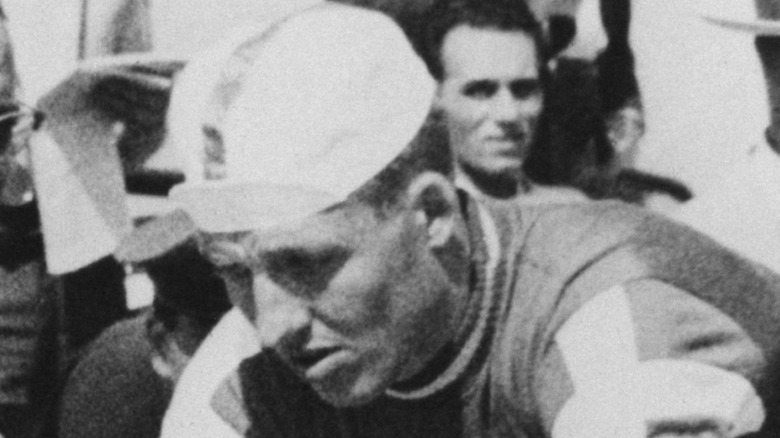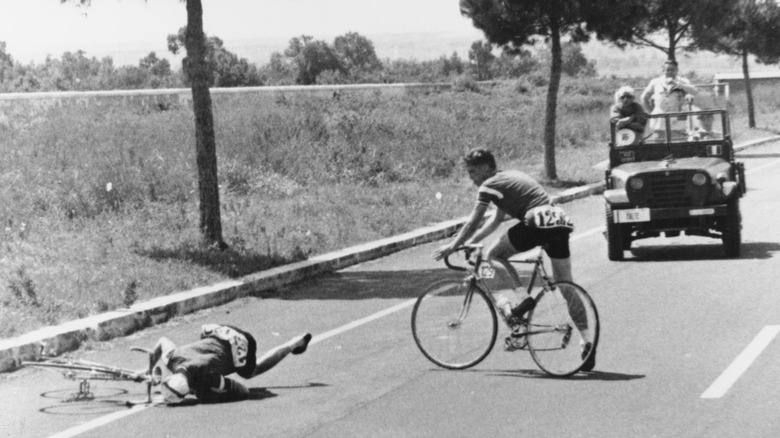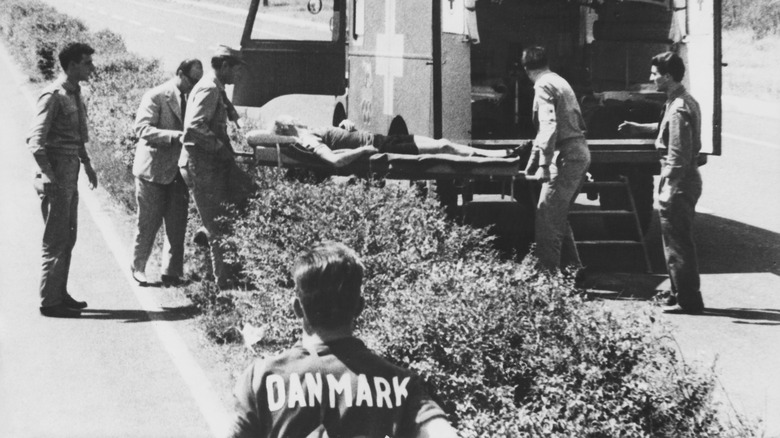Knud Jensen: The Truth About The Cyclist Who Died At The Olympics
Every four years (save for this year's rescheduled 2020 Games), the Olympics offer a chance for the world's best athletes to compete against each other in a wide range of sports. Athletes are, of course, expected to be in the best of shape ahead of their events, but there are countless instances where a competitor suffers an injury or isn't able to complete their event (or has to pull out) due to one health-related reason or another. Unfortunately, there have also been a few cases of athletes who died while competing in the Olympics, including Danish cyclist Knud Enemark Jensen, who died during the 1960 Games in Rome, Italy. According to Sports Reference, Jensen headed into the Olympics with great promise, having helped Denmark win a silver medal in the team trials at that year's Nordic Championships.
Jensen was not the first Summer Olympics competitor to pass away during the Games — back in 1912, Portuguese athlete Francisco Lazaro collapsed about 30 kilometers (19 miles) into the marathon at the 1912 Olympics in Stockholm and died at the Seraphim Hospital the next morning. However, Jensen's case was especially infamous, and for several years after his passing, the accepted narrative was that he was one of the first athletes to die as a result of performance-enhancing drug use. Here's a closer look at Knud Jensen, his death at the 1960 Olympics, and what was confirmed as his actual cause of death.
Jensen died after collapsing during the 100km team trials
As documented by Vice, the 100-kilometer cycling team trials on August 26, 1960, at the Rome Olympics were notable for the fact that temperatures reached as high as 104 degrees Fahrenheit, causing 31 riders to drop out of the race due to heatstroke. That, in and of itself, posed a serious problem for those who remained in the race. However, as journalist Lars Bøgeskov (via Academia.dk) pointed out, the Danish team looked like they had a chance of winning the bronze medal despite how one of its members was among those who bowed out as a result of the extreme heat.
Jensen was about eight kilometers (five miles) away from the finish line when he told his teammates that he was feeling dizzy; with just five kilometers (three miles) left, he was in a semi-conscious state and was lagging behind the other two remaining Danish riders. For a moment, he seemed to regain consciousness as one teammate held his shirt and another sprayed water on him. But after Jensen allowed the first teammate to let go of his shirt, he fainted and fell "heavily onto the scorching asphalt," according to Bøgeskov's account.
Jensen was then transported by an ambulance to the finish line, where he was taken to a military tent for medical assistance. Unfortunately, the temperatures inside the tent were even hotter than they were outside, and at 3:30 p.m. local time, Jensen was pronounced dead at the age of 23.
Doping rumors swirled soon after Jensen's death
It didn't take long for rumors to spread about the possibility that Knud Jensen died because he took drugs ahead of the team trials. According to VeloPress, Danish team trainer Oluf Jørgensen admitted to Jensen's attending doctors that he gave all of his four riders a vascular dilation drug called Roniacol before the race. This only added fuel to the anti-doping fire started by International Olympic Committee medical advisor Ludwig Prokop, who was aggressively pushing for a ban on performance-enhancing substances. On the IOC's official report, he blamed Jensen's death on the amphetamines and Roniacol he had allegedly consumed, even though there was no concrete proof that he was actually doping.
In the aforementioned Academia.dk article, author Verner Møller offered some interesting theories on Jensen and his teammates. He wrote that in the light of Jørgensen's claims, it was highly unlikely that the cyclist's death was connected to the use of amphetamines, as he was performing poorly before he collapsed. However, there was one Danish rider, Niels Baunsøe, who had a good showing in comparison to his teammates and didn't tire out that easily; according to Møller, it's possible that he took some amphetamines on top of the Roniacol allegedly handed out by his trainer. "Amphetamine has a performance-enhancing effect (and Baunsøe did cycle so fast that the others had difficulty in keeping up)," Møller added.
No drugs were found in Jensen's system, but the doping narrative continued for decades
In March 1961, Knud Jensen's official cause of death was finally revealed, and contrary to what was stated on the IOC's report and what the rumor mill alleged, there were no drugs found in the cyclist's system. Per Vice, three Italian doctors conducted an autopsy on Jensen and found that he had suffered heatstroke and fractured his skull after he fell from his bike. The latter seemed particularly plausible, as riders at that time weren't required to wear the crash helmets used by present-day Olympic cyclists.
One would think that the autopsy results would have posthumously cleared Jensen of any doping allegations. That wasn't to be, as Vice wrote that it took several decades before most of the rumors linking the Danish cyclist to drug use were fully debunked. The IOC's Prokop, in fact, reiterated in 1972 (via VeloPress) that Jensen "broke down and died during the Olympics in Rome as a result of an overdose of amphetamine and Roniacol." It was only in 2001 when he admitted that he had never seen anything on Jensen's autopsy that suggested he was using drugs.
While Prokop acknowledged that he was wrong to make such assumptions, he added that the tragic incident nonetheless "initiated the fight against doping." Fair enough, but that doesn't change the fact that a young athlete was inaccurately linked to performance-enhancing drug use for over four decades after his death.



